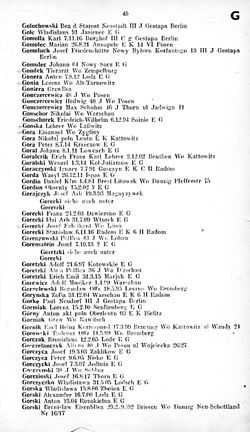Intelligenzaktion
| Intelligenzaktion | |
|---|---|
 Einsatzgruppen executing Poles in Kórnik on 20 October 1939. | |
| Location | Poland |
| Date | 1939 - 1940 |
| Target | Polish intellectuals and the upper classes. |
| Attack type | Massacres |
| Weapon(s) | Automatic weapons |
| Deaths | 60,000 |
| Perpetrators |
|


Intelligenzaktion was a genocidal action of Nazi Germany targeting Polish elites (primarily intelligentsia – teachers, priests, etc.) as part of elimination of potentially dangerous elements.
It was an early measure of the Generalplan Ost. About 60,000 people were killed as the result of this operation. The Intelligenzaktion took place soon after the German invasion of Poland, lasting from fall of 1939 till spring of 1940. It was continued by the German AB-Aktion operation in Poland.[1]
Purpose
These Polish elites were regarded as "Polish masters", an undesirable trait that might cause Poles to disobey their German masters.[2] Hitler himself decreed:[2]
Once more the Führer must point out that the Poles can only have one master, and that is the German; two masters cannot and must not exist side by side; therefore all representatives of the Polish intelligentsia should be eliminated (umbringen). This sounds harsh, but such are the laws of life.
The elite of Polish society were regarded by Nazi racial theories as being most likely of German blood, because their dynamic leadership contrasted with Slavonic fatalism,[3] but the removal of such elements was regarded as necessary to remove leadership from the Polish nation,[2] and because their patriotism and hatred of Germany would prevent full-scale Germanization.[4] Furthermore, German blood must not be used in the service of a foreign nation.[2] (Their children were targeted for abduction and Germanization.[2] Such programs, the Nazis believed, would prevent a resurgence of any intelligentsia).[3]
Method of realization
"(...) The General Government is our work force reservoir for lowgrade work (brick plants, road building, etc.,etc.).(...) Unconditionally, attention should be paid to the fact that there can be no "Polish masters"; where there are Polish masters, and I do not care how hard this sound, they must be killed. (...) The Fuhrer must emphazize once again that for Poles there is only one master and he is a German, there can be no two masters beside each other and there is no consent to such, hence all representatives of the Polish inteligentsia are to be killed. (...) The General Government is a Polish reservation, a great Polish labour camp." - note of Martin Borman from the meeting Dr. Hans Frank with Adolf Hitler, Berlin 2 October 1940.[5]
The action was realized by SS paramilitary death squads – Einsatzgruppen and the paramilitary organization of the German minority in Poland – Volksdeutscher Selbstschutz.[6] The units involved were instructed by their commanders that their role would be far more difficult than merely fighting in battle, having to suppress obstructive populations or carry out executions.[7]
The aim of this action was the elimination of Polish society's elite, defined very broadly as: Polish nobles, intelligentsia, teachers, entrepreneurs, social workers, military veterans, members of national organisations, priests, judges, political activists, and anyone who had attended secondary school.[7] People were arrested according to an "enemies of the Reich list" - Sonderfahndungsbuch Polen prepared before the war by members of the German minority in Poland in cooperation with German Intelligence.
Regional actions
- Intelligenzaktion Pommern – in regional action in Pomeranian Voivodeship 23000 Poles were killed,[8]
- Intelligenzaktion Posen – 2000 victims from Poznań,
- Intelligenzaktion Masovien – regional action in Masovian Voivodeship 1939/1940 – 6700 victims from: Ostrołęka, Wyszków, Ciechanów, Wysokie Mazowieckie, Giełczyn near Łomża were killed.
- Intelligenzaktion Schlesien – in regional action in Silesian Voivodeship 1940 2000 Poles were killed,
- Intelligenzaktion Litzmannstadt – regional action in Łódź 1939 resulted in 1500 people being shot,
- Sonderaktion Krakau – 183 professors from Jagiellonian University were deported to Sachsenhausen,
- Zweite Sonderaktion Krakau
- Sonderaktion Tschenstochau – in Częstochowa
- Sonderaktion Lublin – in regional Lublin action 2000 people were killed, most of whom were priests,
- Sonderaktion Bürgerbräukeller – in Łódź Voivodeship
- Czarny Las Massacre in Stanisławów, some 250 people were killed.
See also
- Nazi crimes against ethnic Poles
- Polish areas annexed by Nazi Germany
References
- ↑ Tadeusz Piotrowski, Poland's holocaust: ethnic strife, collaboration with occupying forces and genocide in the Second Republic, 1918-1947, McFarland, 1998, p. 25.
- ↑ 2.0 2.1 2.2 2.3 2.4 "Chapter XIII - GERMANIZATION AND SPOLIATION"
- ↑ 3.0 3.1 Richard C. Lukas, Did the Children Cry? Hitler's War against Jewish and Polish Children, 1939-1945. Hippocrene Books, New York, 2001.
- ↑ "dac.neu.edu"
- ↑ "Man to man...", Rada Ochrony Pamięci Walk i Męczeństwa, Warsaw 2011, p. 11, English version
- ↑ Andrzej Szcześniak, Generalplan Ost. Plan Zagłady Słowian. Radom: Polskie Wydawnictwo Encyklopedyczne, 2001. ISBN 83-88822-03-9.
- ↑ 7.0 7.1 Richard C. Lukas, Forgotten Holocaust, p. 8. ISBN 0-781-80528-7.
- ↑
- Maria Wardzyńska "Był rok 1939 Operacja niemieckiej policji bezpieczeństwa w Polsce. Intelligenzaktion" IPN Instytut Pamięci Narodowej, 2009 ISBN 978-83-7629-063-8
Further reading
- Maria Wardzyńska, "Intelligenzaktion" na Warmii, Mazurach oraz Północnym Mazowszu. Główna Komisja Ścigania Zbrodni Przeciwko Narodowi Polskiemu. Biuletyn Instytutu Pamięci Narodowej nr. 12/1, 2003/2004, ss. 38-42. ceeol.com
- Andrzej Szcześniak, Generalplan Ost. Plan Zagłady Słowian, Radom: Polskie Wydawnictwo Encyklopedyczne, 2001. ISBN 83-88822-03-9
- Anna Meier, Die Intelligenzaktion. Die Vernichtung Der Polnischen Oberschicht Im Gau Danzig-Westpreusen, VDM Verlag Dr. Müller. ISBN 3-639-04721-4; ISBN 978-36-3904-721-9
- Maria Wardzyńska, Był rok 1939 Operacja niemieckiej policji bezpieczeństwa w Polsce. Intelligenzaktion, IPN Instytut Pamięci Narodowej, 2009. ISBN 978-83-7629-063-8
External links
- Elżbieta Grot, Ludobójstwo w Piaśnicy z uwzględnieniem losów mieszkańców powiatu wejherowskiego ("Genocide in Piaśnica with a discussion of the fate of the inhabitants of Wejherow county"), Public Library of Wejherowo,
- Tadeusz Piotrowski, Poland's holocaust: ethnic strife, collaboration with occupying forces and genocide in the Second Republic, 1918-1947, McFarland, 1998, p. 25,
- (Polish) Intelligenzaktion, Encyklopedia WIEM
- (Polish) Intelligenzaktion, Encyklopedia PWN
| |||||||||||||||||||||||||||||||||||||||||||||||||
